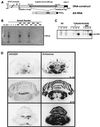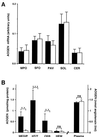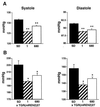Blood pressure reduction and diabetes insipidus in transgenic rats deficient in brain angiotensinogen
- PMID: 10097148
- PMCID: PMC22405
- DOI: 10.1073/pnas.96.7.3975
Blood pressure reduction and diabetes insipidus in transgenic rats deficient in brain angiotensinogen
Abstract
Angiotensin produced systemically or locally in tissues such as the brain plays an important role in the regulation of blood pressure and in the development of hypertension. We have established transgenic rats [TGR(ASrAOGEN)] expressing an antisense RNA against angiotensinogen mRNA specifically in the brain. In these animals, the brain angiotensinogen level is reduced by more than 90% and the drinking response to intracerebroventricular renin infusions is decreased markedly compared with control rats. Blood pressure of transgenic rats is lowered by 8 mmHg (1 mmHg = 133 Pa) compared with control rats. Crossbreeding of TGR(ASrAOGEN) with a hypertensive transgenic rat strain exhibiting elevated angiotensin II levels in tissues results in a marked attenuation of the hypertensive phenotype. Moreover, TGR(ASrAOGEN) exhibit a diabetes insipidus-like syndrome producing an increased amount of urine with decreased osmolarity. The observed reduction in plasma vasopressin by 35% may mediate these phenotypes of TGR(ASrAOGEN). This new animal model presenting long-term and tissue-specific down-regulation of angiotensinogen corroborates the functional significance of local angiotensin production in the brain for the central regulation of blood pressure and for the pathogenesis of hypertension.
Figures






Similar articles
-
Glial angiotensinogen regulates brain angiotensin II receptors in transgenic rats TGR(ASrAOGEN).Am J Physiol Regul Integr Comp Physiol. 2001 Jan;280(1):R233-40. doi: 10.1152/ajpregu.2001.280.1.R233. Am J Physiol Regul Integr Comp Physiol. 2001. PMID: 11124156
-
Differential regulation of central vasopressin receptors in transgenic rats with low brain angiotensinogen.Regul Pept. 2004 Jul 15;119(3):177-82. doi: 10.1016/j.regpep.2004.02.001. Regul Pept. 2004. PMID: 15120478
-
Prevention of sympathetic and cardiac dysfunction after myocardial infarction in transgenic rats deficient in brain angiotensinogen.Circ Res. 2004 Apr 2;94(6):843. doi: 10.1161/01.res.0000120864.21172.5a. Circ Res. 2004. PMID: 15061159
-
Genetic targeting of the brain renin-angiotensin system in transgenic rats: impact on stress-induced renin release.Acta Physiol Scand. 2004 Aug;181(4):579-84. doi: 10.1111/j.1365-201X.2004.01333.x. Acta Physiol Scand. 2004. PMID: 15283773 Review.
-
Transgenic rats: tools to study the function of the renin-angiotensin system.Clin Exp Pharmacol Physiol. 1996 Sep;23 Suppl 3:S81-7. doi: 10.1111/j.1440-1681.1996.tb02818.x. Clin Exp Pharmacol Physiol. 1996. PMID: 21143278 Review.
Cited by
-
Brain renin-angiotensin system in the nexus of hypertension and aging.Hypertens Res. 2013 Jan;36(1):5-13. doi: 10.1038/hr.2012.161. Epub 2012 Oct 18. Hypertens Res. 2013. PMID: 23076408 Free PMC article. Review.
-
Renin-Angiotensin system and sympathetic neurotransmitter release in the central nervous system of hypertension.Int J Hypertens. 2012;2012:474870. doi: 10.1155/2012/474870. Epub 2012 Nov 21. Int J Hypertens. 2012. PMID: 23227311 Free PMC article.
-
Update on tissue renin-angiotensin systems.J Mol Med (Berl). 2008 Jun;86(6):615-21. doi: 10.1007/s00109-008-0336-0. Epub 2008 Apr 15. J Mol Med (Berl). 2008. PMID: 18414822 Review.
-
Brain Renin-Angiotensin System as Novel and Potential Therapeutic Target for Alzheimer's Disease.Int J Mol Sci. 2021 Sep 20;22(18):10139. doi: 10.3390/ijms221810139. Int J Mol Sci. 2021. PMID: 34576302 Free PMC article. Review.
-
The brain renin-angiotensin system plays a crucial role in regulating body weight in diet-induced obesity in rats.Br J Pharmacol. 2016 May;173(10):1602-17. doi: 10.1111/bph.13461. Epub 2016 Mar 27. Br J Pharmacol. 2016. PMID: 26892671 Free PMC article.
References
-
- Oparil S, Chen Y-F, Berecek K H, Calhoun D A, Wyss J M. In: Hypertension: Pathophysiology, Diagnosis, and Management. Laragh J H, Brenner B M, editors. New York: Raven; 1995. pp. 713–740.
-
- Freis E D. In: Hypertension: Pathophysiology, Diagnosis, and Management. Laragh J H, Brenner B M, editors. New York: Raven; 1995. pp. 2741–2751.
-
- Reid I A, Morris B J, Ganong W F. Annu Rev Physiol. 1978;40:377–410. - PubMed
Publication types
MeSH terms
Substances
LinkOut - more resources
Full Text Sources
Other Literature Sources
Medical

